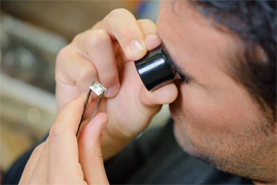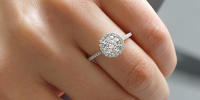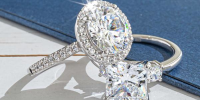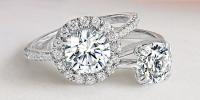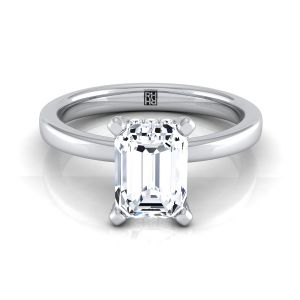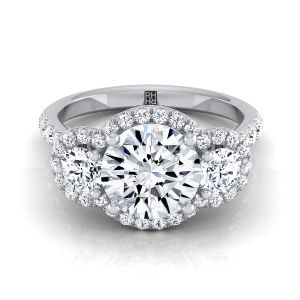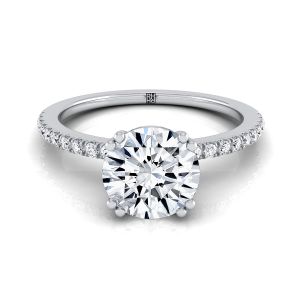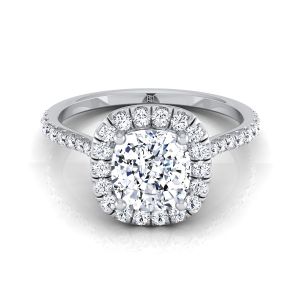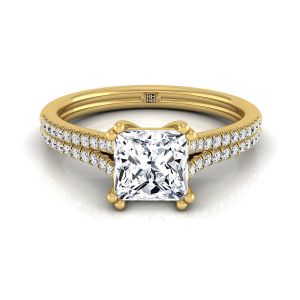1. Make Sure the Diamond is Certified by GIA or AGS
It’s impossible to shop for loose diamonds without an accurate assessment of diamond quality. To make sure that you know what you are getting, it’s essential that you choose a certified diamond with a grading report from the Gemological Institute of America or American Gem Society Laboratories, known as GIA and AGS. These two labs are globally respected non-profit institutions that have a mission to protect consumers. GIA is the world standard: they invented the 4Cs and the diamond grading system used worldwide. AGS is the pioneer of diamond cut grading and the first to issue ideal cut grades. Why does it matter if the diamond is graded by one of these leading labs? Because they are generally considered to be accurate and impartial. The market assumes that grades from any other laboratory are less accurate and less strict and so diamonds with these reports are worth less. You can’t really compare them to diamonds with GIA reports. The discount diamonds with other reports sell for varies from lab to lab but it’s the uncertainty about the quality that makes buying a loose diamond with any other report risky. (At RockHer we only sell diamonds with GIA reports.) We recommend that you have your GIA diamond grading report number engraved on the girdle of your loose diamond so you can easily identify it and confirm it is the diamond on the grading report.2. Choose Your Shape
The first step to finding the best loose diamond for you is choosing a shape. The round brilliant shape is the most popular. It has the classic look you’ve seen in a thousand solitaires. Thanks to GIA and AGS cut grades, round brilliant cut loose diamonds are also the easiest diamonds to buy. If you choose a round diamond with an excellent cut grade from GIA, popularly known as an ideal cut, you’re sure to own a beautiful and well-crafted diamond. You can also buy an even better cut diamond: a round brilliant hearts and arrows diamond which demonstrates superior light performance when evaluated with a viewer. But it’s also important to note that round brilliant cut diamonds are the most expensive loose diamonds on the market too. By choosing a fancy shape like an oval, cushion, or princess cut, you can save as much as 20% per carat! Some fancy shape diamonds also look larger than a round brilliant diamond that is the same number of carats. (Our guide to diamond sizes and shapes has images that will show you how much larger.) If you want a fancy shape but also want the brilliance of a hearts and arrows diamond you can have both with the Brilliant Cushion, a hearts and arrows cushion cut diamond.3. Set Your Budget
The next step to finding the right loose diamond is setting your budget. How many thousands of dollars are you prepared to spend? (You can buy a nice half-carat diamond for less than a thousand but most people who are shopping for a loose diamond have a budget measured in thousands, not hundreds. According to The Knot, the average engagement ring today is $6,351.) You also have to make a choice on whether you are prioritizing quality, even if it means smaller, or prioritizing size, even if it means lower in quality. At this point you can start researching the 4Cs of diamond quality, ideal proportions, price per carat size boundaries, and other factors like fluorescence and location of inclusions that can decrease a diamond’s value, or you can let ROSI, a diamond-picking artificial intelligence powered by IBM’s Watson, weigh all those factors for you. We aren’t math geniuses so we prefer to let the computer crunch the numbers: ROSI has been trained by diamond dealers on how to balance 30 diamond quality factors to find the best loose diamond value for your budget.4. Be Responsible
Make sure you buy your loose diamond from a company that demonstrates a commitment to responsible sourcing. Supporting the Kimberley Process is a great start but we think the diamond industry should go beyond it, sourcing diamonds directly from sightholders and mines whenever possible. And we also think your jewelry should be crafted from recycled gold and platinum too.5. Keep Your Diamond Safe
The best way to keep a loose diamond is to store it individually in a parcel paper or plastic box along with its grading report. If you store it in a box, make there is foam to hold it in place so it doesn’t rattle around. Remember diamonds can chip and diamonds can scratch other diamonds and gemstones. Don’t wrap a loose diamond in a twist of paper or cotton and tuck it in a jewelry box: there are too many stories of diamonds that were inadvertently thrown away. (One famous one was a five-carat red diamond hidden away in Germany before the war that would be worth millions today.) We recommend insuring your diamond either by buying a Jewelers Mutual policy or by adding a rider on your home insurance policy (if your insurance company offers it.) Don’t assume it’s covered under your existing policy: it probably isn’t.6. Get Ready to Get Set
Now that you have your beautiful loose diamond, it’s time to set it into an engagement ring or another piece of jewelry. Your options are limited only by your imagination but most people choose a classic style that will last generations. If you are planning a surprise proposal with this diamond, you can choose to do it with or without a surprise ring. For a surprise ring, most of our customers choose a classic solitaire engagement ring, usually on a pave band, or a halo engagement ring, which makes the center diamond look larger. If she’s dropped some hints of what she likes, deciding on a design is easier. (If you haven’t noticed any hints yet, give her a chance. Comment on someone else’s ring and see what she says or go window shopping.) If you prefer not to decide on the design of the ring yourself, you have two options. First, you can propose with the loose diamond and design the ring afterwards together. You can use a ring holder or plain solitaire setting to make it easier to present the diamond (but be extremely careful with diamond holder rings: the diamond slips out easily.) This has the advantage of preserving the element of surprise but the drawback of having no ring when you announce the engagement (and the first thing every single person she tells about the engagement will say is “Let me see the ring!”) Engagement ring selfies are basically the standard engagement announcement: you won’t be able to do that either. Instead you can talk about the ring and even choose it together but still keep the proposal itself a surprise. This might remove some of the surprise but, honestly, it should be clear to her that a proposal is coming soon anyway. We think this is a great solution: you’ll have to work a bit harder to make the proposal surprising in some way but the engagement ring will be exactly what she wants, which is important too.










